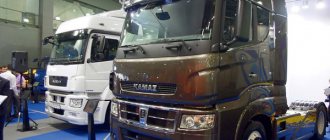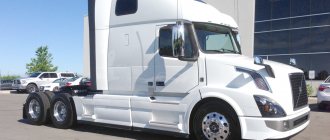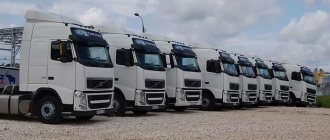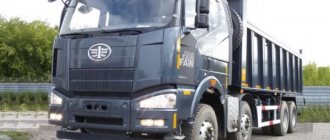The Volvo VHD is the most popular truck in North America. The Swedish company manages to offer the best combination of power, versatility and, of course, price every year. The model is widely used by construction, utility and mining companies, as the VHD is offered in the form of a dump truck, tractor, utility vehicle, truck crane, CMU, etc.
Recently, along with the presentation of European trucks, the company introduced the updated 2022 VHD. The new product has become even more versatile, technologically advanced, and has acquired additional useful elements and on-board functions.
Specifications
Regarding the main aggregate components, the changes are extremely minor. If we put aside the innovations in on-board assistants, only the output of the engines has changed, the same ones that were in the predecessor. So let's start with them.
Related article: Volvo VNL 2022 is one of the best modern tractors in the whole world
The VHD is equipped with two options of diesel engines - D11 with boost from 325 to 425 hp, and D13 with power options from 375 to 500 hp. The predecessor's minimum performance was almost 50 hp. less.
Both engines are in-line sixes, have direct injection and 24 valves. The volume is 11 and 13 liters, respectively (this is indicated by the last digit of the index).
The power will be controlled by the i-Shift intelligent automatic transmission, the Swedes’ own development. Now it is installed on absolutely the entire updated range of trucks. It has 12 tracked gears and rear wheel drive.
Its peculiarity is that it makes it possible to effectively launch at steep angles even with a maximum load (VHD is designed for 36,287 kg), while quickly reaching maximum speed on the highway.
It's also worth talking about the "cart". Like the entire model range, the truck has a cold-rolled steel frame, which is based on the proprietary T-Ride air suspension (a hinge joint is used).
As experienced drivers note, even in the most severe conditions, the system provides uniform pressure on the wheels and maintains stable traction with optimal rigidity.
Additionally, the VHD gets front and rear disc brakes, hydraulic power steering, rack and pinion steering and three wheel configurations: 6x4, 8x4 and 8x6. All three axles are driven.
More on the topic: Volvo FM Truck 2022 new truck with the most comfortable cabin in the world
Like its predecessor, Volvo will offer the truck in versions such as a tractor unit, a dump truck, a mixer (concrete mixer), a snow blower, a crane, etc.
As for updates regarding smart electronics, the changes are more dramatic. Now on board is a proprietary dynamic control system and a new generation of driving assistant, in other words, cruise control.
The first function hides quite an interesting application potential. In conjunction with an intelligent gearbox, the system independently determines the need to add torque, reduces steering loads and eliminates unwanted vibrations on rough terrain.
The new cruise boasts integrated radar capabilities and improved camera visibility. A close connection with the emergency braking system, lane control and the highway departure warning function is also programmed here.
Read: How EBD Brake Force Distribution System Works
Regarding the software, we also cannot fail to note the new function for diagnosing truck faults in real time. It is enough to use the special menu of the on-board computer.
All goes to good
The specifications for the 2022 Volvo 9700 DD double decker indicate that the height of the bus is 4 m, the length is from 13.0 to 14.8 m (this is more than the previous version). Wheelbase - from 5360 to 7160 mm. Reducing the height of the buses apparently required some changes in the design of the frame and the technological process of manufacturing the machine. The designers did not waste time and created three versions at once, complementing the Volvo Buses product range. The first version is intended for use on regular high-speed lines of transport systems such as BRT. The second is a vehicle for express transportation, apparently for corporate purposes. The third version is a premium car.
The focus of Volvo Trucks management on the double-decker bus is not accidental - this segment is in growing demand among transport operators in Europe. The new bus is based on the same platform as the 4.25 m high Volvo 9700 DD. The aim was to make it universal so that it could be adapted to different customer requirements and operational needs at minimal cost. And of course, the bus is equipped with various active safety and driver assistance systems, I’ll mention the most important ones: lane keeping; collision warning followed by emergency braking, electronically controlled brakes, stabilization and anti-skid systems.
In his speech, Ulf Magnusson noted that the car has expanded capabilities for external control of all systems and for optimizing its movement on highways. For example, in areas with familiar terrain, the bus itself decides what maximum speed it should travel at, slows down on descents and accelerates before ascending. This has a positive effect on both safety and fuel consumption.
The designers say they have improved the suspension system while reducing the weight of the double-decker bus frame, thereby ensuring a low center of gravity and excellent road stability. The cabin is quiet. The seats are ergonomic, of our own design. The presented version of the bus has 96 seats - this is an average compromise, but in reality there can be from 86 to 99 seats. Climate system with separate zones for passengers and the driver. The driver's cabin in the new double-decker bus is spacious and elevated for a better view of the road.
Appearance
Externally, VHD has been updated slightly. The architecture of the radiator grille, optics, the shape of the doors and rear-view mirrors has been tweaked in some places. It is worth special mentioning the front dimensions and the new towing pin.
The first ones are represented by LED optics, have a sealed design, anti-icing function and focusing of light rays. The second one is now made of ultra-strong 45 mm steel, is tightly integrated into the bumper and will help you get out of any difficult situation.
It is also impossible not to mention 4 cab options: day cabs (that is, without a berth) with the index 300 AB and 300 AF (differing in the long overhang of the front part) and with a berth - 400 AB and 400 AF (also available with different lengths of the front end)
Dimensions 300 AF:
| Length, mm | Width, mm | Height, mm | Wheelbase, mm |
| 6300 | 2550 | 3800 | 3000 |
Need to match
The chassis of the 4-meter Volvo 9700 DD is B11RLE with a 6x2 wheel arrangement. To reduce the turning radius, the last axle of the rear bogie is steering. The bus is equipped with an 11-liter D11K460 engine with a power of 460 hp, which is certified to run on diesel, HVO and biodiesel (B100). The power unit, of course, meets the Euro-6 environmental standard and works in tandem with the I-Shift automatic transmission, which provides the most economical and comfortable control of the car. The frame and side outer panels are made of stainless steel. Swedish specialists managed to increase the volume of the luggage compartment to 8 m3. Upon request, a storage room and toilet can be installed in the salon.
The bus does not have external rear-view mirrors, instead there are cameras. The displays are located in the corners of the windshield on pillars, so the driver does not have to get used to it - the image is located where the rear-view mirrors should be.
In short, the Swedish company has done everything to meet European standards. The Volvo 9700 DD double decker, tested over the course of a year, seems to have a good reputation, although there is very little information, and besides, it was a completely different bus. Now let's see how passenger transport operators from the EU will react to the 4-meter new product.
Salon
The interior, as is already clear, will be presented in two variations, with and without a sleeping bunk. The day version has smaller cabin dimensions and that's all. Except that the latter also does not have additional storage compartments.
Otherwise, Volvos offer excellent driver-oriented torpedo ergonomics, a gearshift lever fixed directly on the driver’s seat, a multifunction steering wheel with a rich set of buttons, a multimedia touchscreen, an on-board computer screen mixed with an analog instrument panel and a whole cascade of physical buttons.
Competitors
Considering that VHD is offered exclusively for the American market and generally reflects the religion of freight transport in the local culture, the competitors of the new product are represented by local manufacturers, who are mainly scaled only on the North American continent.
Similar solutions are offered by Kenworth, Freightliner, International, Mack, etc.









